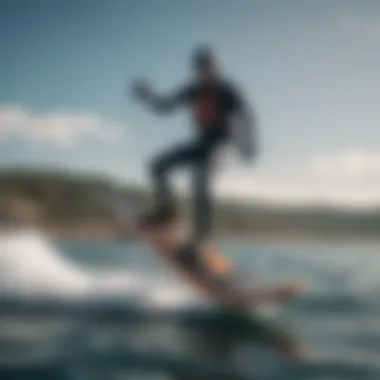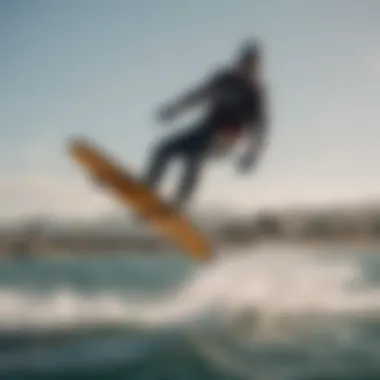Exploring Hydrofoil Kiting: Techniques and Gear


Intro
Hydrofoil kiting is more than just a trend; it represents a transformative shift in the kitesurfing experience. The blend of hydrofoil technology and kitesurfing opens new realms of performance and excitement on water. For both beginners and seasoned athletes, understanding this discipline requires a grasp of essential equipment, various techniques, and critical safety considerations.
The purpose of this article is to dissect hydrofoil kiting into digestible parts. Each section will explore the mechanics at play, the hardware involved, and the diverse skills needed to navigate the craft effectively. With this knowledge, participants can elevate their kitesurfing experience, whether they are gliding across crystal-clear waters for the first time or perfecting advanced maneuvers.
As kitesurfing gains popularity, the community surrounding it continues to grow, fostering an environment where enthusiasts can share insights and support. Our exploration will include in-depth reviews of gear, techniques tailored to skill levels, and safety guidelines that ensure enjoyable experiences in every outing on the water.
In a sport that blends artistry with athleticism, grasping the subtleties of hydrofoil kiting can lead to a greater appreciation for the dynamics involved. Let us begin with our first thematic area: Equipment Reviews.
Preamble to Hydrofoil Kiting
Hydrofoil kiting is increasingly become a focal point in the kitesurfing community. This sport offers riders unique experiences by enabling them to glide above the water's surface. Understanding hydrofoil kiting is essential as it incorporates advanced technology and distinct techniques, making it both exciting and challenging.
The significance of hydrofoil kiting lies in its ability to change how enthusiasts interact with water sports. It promotes a different skill set compared to traditional kitesurfing, requiring awareness of dynamics related to hydrofoils and their impact on riding.
Definition of Hydrofoil Kiting
Hydrofoil kiting can be defined as a variant of kitesurfing where the boards are equipped with hydrofoils. These hydrofoils are underwater wings that lift the board above the surface as the rider gains speed. This lift allows for a smoother ride, significantly reducing drag and enabling the rider to traverse rough waters with less resistance. Riders utilizing hydrofoils also benefit from prolonged sessions in lighter winds, making the sport more versatile for various conditions.
History of Hydrofoil Kiting
The origins of hydrofoil kiting date back to the late 1960s when inventors designed the first hydrofoil for sailing. However, it wasn't until the 1990s that the concept took a foothold in kitesurfing. Early adopters saw the potential benefits, and innovations followed. By the early 2000s, several manufacturers began experimenting with hydrofoil designs specifically for kitesurfers. Over time, it has developed into a niche sport with a dedicated following.
Today, hydrofoil kiting continues to evolve. New materials and designs improve performance, safety, and accessibility. As awareness of this sport grows, many are drawn to its technical challenges and the exhilaration of soaring above the water.
Understanding Hydrofoil Technology
Understanding hydrofoil technology is crucial for anyone interested in hydrofoil kiting. This technology fundamentally transforms the kitesurfing experience by introducing elements that improve efficiency and performance. Hydrofoils allow riders to glide above the water surface, reducing drag and increasing speed. This leads to a unique sensation that many kitesurfers find exhilarating. Moreover, grasping the mechanics behind hydrofoil technology is important for optimizing performance and avoiding common pitfalls when learning this sport.
Principles of Hydrodynamics
At the heart of hydrofoil technology lie the principles of hydrodynamics. These principles govern how objects interact with water. Hydrofoils work by utilizing lift, similar to an airplane wing, where the foil's shape creates a pressure differential. When the foil is immersed in water and pushed forward, water flows faster over the top surface than the bottom surface, generating lift.
This lift allows the board to rise above the water, minimizing the surface area in contact with it. As a result, drag is markedly reduced, enabling the rider to cruise smoothly at higher speeds. Understanding these principles is essential for riders who want to maximize their performance and enjoy the nuances of hydrofoil kiting. Riders should practice using various angles of attack on the hydrofoil to see how it affects lift and control.
Components of a Hydrofoil
A hydrofoil consists of several key components that contribute to its effectiveness on water. These components include:
- Mast: The vertical structure that connects the board to the foil. The height of the mast affects how high the board rises above the water.
- Wings: The horizontal parts that create lift. Different wing shapes and sizes can lead to different performance characteristics and sensations.
- Fuselage: The connecting piece between the mast and wings, providing stability and allowing for adjustments.
- Board: The platform on which the rider stands. Hydrofoil boards differ from traditional boards, as they must accommodate the hydrofoil's mounting.
Understanding these components helps riders choose the right setup for their specific needs and preferences, making this knowledge a pillar of effective hydrofoil kiting.
Comparison with Traditional Kitesurfing
One of the most significant distinctions between hydrofoil kiting and traditional kitesurfing is the way they interact with water. In traditional kitesurfing, the board remains entirely submerged, relying on the rider's skill to manage board speed and direction while skating on the water.
In contrast, hydrofoil kiting allows the rider to lift off the water entirely. This added elevation offers numerous advantages, including:


- Increased Speed: The reduction in drag allows for smoother and faster rides.
- Smoother Riding Experience: Riders can navigate over choppy water conditions with less impact.
- Extended Season: Hydrofoils perform well in lighter winds, expanding the usability of the sport.
Hydrofoil kiting presents a different set of challenges, particularly in terms of balance and control, which can be daunting for beginners. However, mastering these new techniques rewards riders with an exhilarating kitesurfing experience.
"Hydrofoil kiting is not just a new way to ride; it is an evolution that redefines the very essence of kitesurfing."
In summary, understanding hydrofoil technology equips riders with essential knowledge that enhances their hydrofoil kiting experience. From knowing the principles of hydrodynamics to grasping the essential components and comparing it with traditional kitesurfing, this foundation is critical for anyone looking to master this exciting sport.
Equipment Required for Hydrofoil Kiting
When embarking on the adventure of hydrofoil kiting, choosing the right equipment is pivotal. The gear significantly affects your performance, safety, and overall experience on the water. Investing in quality equipment tailored for hydrofoil kiting elevates the sport to new heights, literally and metaphorically. Proper equipment not only enhances the joy of riding but also mitigates risks associated with the sport.
Selecting the Right Hydrofoil
Choosing the right hydrofoil is crucial. Hydrofoils come in various designs and sizes, affecting performance and ease of use. The primary factors to consider include the surface area, aspect ratio, and material construction.
- Surface Area: A larger surface area can make it easier to lift off the water, especially for beginners. However, it might create more drag when maneuvering at speed.
- Aspect Ratio: A higher aspect ratio usually results in better performance and efficiency. These foils glide effectively through water, suitable for advanced techniques and speeds.
- Material: Different materials like aluminum and carbon fiber affect the weight and durability of the hydrofoil. Carbon fiber provides a lightweight advantage, which enhances maneuverability.
When selecting a hydrofoil, consider your skill level and the conditions in which you will be riding. Contact local retailers or experienced riders for recommendations tailored to your needs.
Choosing the Appropriate Kite
The kite plays an equally vital role in your hydrofoil kiting experience. Selecting the right kite involves understanding several factors including size, design, and your intended riding style.
- Size: Kites come in various sizes, which affects power and control. In light wind conditions, a larger kite helps you get airborne and provides more lift. Conversely, smaller kites are better in strong winds, as they offer increased control and reduce the risks of overpowering.
- Design: There are various kite designs such as C-kites and Delta kites. Each type has different flight characteristics, and understanding these differences will help you make an informed choice.
- Bar Control and Lines: The steering system has a big impact on your ability to control the kite. Look for a control bar that feels comfortable and intuitive. The length of the lines also influences your responsiveness on the water.
Matching the kite type and size with your skill level and riding environment is essential. Getting expert advice can guide you in making the best choice.
Essential Safety Gear
Safety cannot be overlooked in hydrofoil kiting. Wearing the correct safety gear is paramount for every rider. The right gear can prevent injuries and enhance your confidence in water.
- Helmet: A well-fitted helmet protects your head from falls and potential collisions. Opt for a helmet designed for water sports, ensuring it is lightweight yet durable.
- Impact Vest: An impact vest cushions your body during falls and provides some buoyancy. Choose a vest that allows freedom of movement while offering sufficient protection.
- Leash: A safety leash ensures your kite is attached to you at all times. This prevents loss of the kite and controls its movement in case of a fall.
- Wetsuit: Depending on the water temperature, a wetsuit may help keep you warm and provide protection against abrasions.
- Floatation Device: For beginners, a personal flotation device adds an extra layer of safety on the water. It can be helpful, especially in challenging conditions.
Learning Techniques for Hydrofoil Kiting
Learning techniques for hydrofoil kiting is essential for anyone looking to excel in this dynamic sport. The key components of this learning process include mastering basic riding techniques, developing advanced maneuvering skills, and understanding common pitfalls. By addressing these areas, riders can enhance their experience on the water and minimize risks associated with hydrofoil kiting.
Basic Riding Techniques
To commence the journey of hydrofoil kiting, riders must first familiarize themselves with basic riding techniques. These foundational skills provide a crucial framework for further development. Key points to consider include:
- Starting Position: A good stance is vital. Position feet shoulder-width apart. Keep a slight bend in the knees for stability.
- Kite Control: Learning how to control the kite properly is critical. Practice steering with smooth movements. Use the power of the kite to lift off the water gradually.
- Foil Lift-Off: Focus on the transition from riding on the board to lifting off the hydrofoil. Lean slightly back at the initial takeoff. This action will help the foil generate lift more efficiently.
- Balance: Balance is key when riding. Riders should shift their weight based on foil responsiveness. Small weight adjustments can greatly affect speed and control.
These basic techniques are important for ensuring safety and effectiveness while riding. Consistent practice is necessary for mastering these skills.
Advanced Maneuvering Skills
Once the basic techniques are established, riders should explore advanced maneuvering skills. This includes incorporating complex maneuvers that enhance performance and versatility. Considerations include:


- Turning Techniques: Efficient turns are crucial. Riders can practice carving turns by applying pressure on the back foot while leaning into the turn. This creates a tighter arc and allows for smoother transitions.
- Jumping Skills: Learning how to jump with a foil is exciting yet challenging. Begin with small hops, gradually increasing height over time. It is important to maintain kite control during jumps.
- Riding Switch: Riding switch is essential for developing ambidexterity. Riders should practice riding with their non-dominant foot forward. This skill increases adaptability on the water and can enhance overall performance.
- Tricks Exploration: As confidence builds, riders can explore tricks such as spins and flips. These should only be attempted once a solid foundation is established.
Developing advanced skills leads to a more rewarding experience on the water. It allows for greater expression in riding and opens opportunities for competition.
Common Mistakes and How to Avoid Them
Even experienced riders make common mistakes that can lead to accidents or difficulties. Awareness and understanding of these pitfalls can improve safety and enjoyment. Here are some frequent errors and tips to avoid them:
- Over-using the Power of the Kite: New riders often pull too hard on the control bar. This can cause the kite to stall. Instead, focus on subtle control and proper timing.
- Incorrect Body Positioning: Many riders fail to maintain the correct stance. Keep a low center of gravity for stability. This can prevent falls and enhance control.
- Neglecting Safety Gear: Failing to wear appropriate safety equipment can lead to serious injuries. Always don a harness, helmet, and impact vest.
- Ignoring Wind Conditions: Riding in unsuitable wind conditions is risky. Always check the forecast and be cautious in shifting weather.
By recognizing these common mistakes, riders can significantly reduce their chances of injury. Implementing good practices will create a safer riding environment.
"Hydrofoil kiting is not just about skill; it's also about preserving one's safety and maximizing enjoyment on the water."
Safety Considerations in Hydrofoil Kiting
Safety in hydrofoil kiting cannot be overstated. As an extreme sport, it inherently carries risks. Understanding these risks and implementing safety measures can make the difference between a thrilling experience and a dangerous one. Hydrofoil kiting allows riders to glide above water, harnessing wind power in a way that elevates the sport. Nevertheless, with great excitement comes significant responsibility.
Understanding Risks and Hazards
There are a variety of risks associated with hydrofoil kiting. The most common hazards involve collisions with obstacles, such as buoys, other riders, or even marine life. The hydrofoil's design allows for high speeds and elevation, but this also increases the chances of losing control. Riders need to keep a keen eye on the surroundings. In addition, the inherent instability of a hydrofoil can lead to wipeouts, which can cause injuries, especially to the arms or legs. Another danger lies in unpredictable weather conditions. Sudden changes in wind speed can catch even experienced riders off-guard.
Importance of Proper Training
Proper training is crucial for anyone looking to engage in hydrofoil kiting. Taking lessons from certified professionals can provide valuable insights into techniques and safety protocols. Novice riders should start on flat water, away from crowds, to practice skills safely. Learning how to control the kit and understand the hydrofoil's behavior under different wind conditions can minimize risks. Additionally, being aware of local laws and regulations helps in understanding where one can kite safely.
Recommended Safety Practices
Implementing recommended safety practices enhances protection for riders. Here are several important practices to follow:
- Wear a Life Jacket: Always wear a personal flotation device. This adds an essential layer of safety in the event of a fall or mishap.
- Check Equipment Regularly: Inspect your gear before each session. Look for wear and tear, especially on the kite, lines, and hydrofoil. Ensure everything is functioning properly.
- Use a Quick Release Mechanism: Equip yourself with a quick-release system. This allows for rapid detachment from the kite in emergencies.
- Kite with a Buddy: Whenever possible, kite with a partner. Having someone nearby can be invaluable in case of unexpected troubles.
- Stay Informed: Keep abreast of weather forecasts and local conditions. Avoid kiting in strong gusts or deteriorating weather.
"The only bad session is the one you don’t learn from. Observing safety is the first step towards mastering hydrofoil kiting."
By understanding the risks, valuing proper training, and adhering to safety practices, riders can significantly reduce the dangers associated with hydrofoil kiting. This sport offers immense joy, but it requires respect for the elements and oneself.
The Community and Culture of Hydrofoil Kiting
The essence of any sport lies beyond just the techniques and equipment; it encompasses the people who make it vibrant and evolving. The community and culture of hydrofoil kiting contribute significantly to the sport's growth. Riders exchange knowledge, share experiences, and foster a culture that reinforces safety, innovation, and inclusivity.
Building connections within this niche allows participants to enhance their enjoyment of the sport. Communities often organize events where kitesurfers gather to demonstrate skills and celebrate their shared passion. These gatherings strengthen bonds among riders and create an environment for learning.
Key Competitions and Events
Several competitions define the landscape of hydrofoil kiting. They set benchmarks for skill and innovation. Events like the Hydrofoil Pro Tour and Red Bull Kite Surf offer platforms for riders to showcase their abilities. Competition not only pushes individual performers but encourages the development of new techniques and equipment as well.
The thrill of these events captivates both participants and spectators. They highlight the journey from individual practice to a collective celebration of achievement in the sport. Riders gain exposure, which can lead to sponsorships, while fans enjoy high-caliber performances and innovative displays.
Influential Figures in the Sport


The journey of hydrofoil kiting is marked by standout figures who shape the sport's direction. Athletes and innovators like Robby Naish and Antoine Albeau inspire newcomers and seasoned riders alike. Their contributions often extend beyond just personal achievement; they involve mentoring, promoting safety practices, and pushing technological advancements.
These influential figures create role models for aspiring kitesurfers. Their presence elevates the community's standards and inspires a continuous desire for progression. Riders are not only vying for personal records but also reaching out to be part of a larger narrative guided by these prominent athletes.
Online Resources and Forums
In today’s digital age, online resources serve as vital components of the hydrofoil kiting community. Platforms such as Reddit and dedicated Facebook groups allow riders to connect, share tips, and seek advice. Websites enriched with tutorials and forums provide spaces for discourse surrounding techniques, equipment recommendations, and safety measures.
These online communities foster an inclusive atmosphere where novices feel welcome to ask questions and share experiences. They allow instant global access to knowledge, which bridges gaps that distance might create. Riders can learn from others’ mistakes, discover new gear, or even find local partners for their next adventure.
The fusion of community and culture in hydrofoil kiting creates a robust network that supports growth and innovation while ensuring a shared commitment to safety and fun.
Future Trends in Hydrofoil Kiting
The realm of hydrofoil kiting is evolving rapidly. Understanding future trends is critical for enthusiasts. It not only informs them about what to expect but also helps in preparing for advancements in technology and participation rates. This section will explore the upcoming technological innovations and the potential growth of the sport.
Technological Innovations on the Horizon
New technologies are emerging in hydrofoil kiting. These innovations promise to enhance performance and safety for riders. Key aspects include:
- Materials: Use of lighter, more durable materials will lead to improved kites and foils. Carbon fiber and advanced composites are becoming common, making gear easier to handle.
- Design Improvements: Foil design is getting more sophisticated. New shapes and techniques for wing construction are providing better lift and stability. This enhances user experience, especially for beginners who find it challenging to balance.
- Smart Technology: Integration of sensors and smart tech into equipment is in the future. This may include real-time data on speed, position, and performance metrics, allowing athletes to analyze their rides for improvement.
These technological shifts can attract new participants while keeping existing ones engaged. It's important for riders to stay informed for maximizing the benefits from advancements.
Potential Growth of the Sport
The sport of hydrofoil kiting is gaining traction. Factors influencing its growth include:
- Increased Accessibility: More stores offer hydrofoil kiting equipment. This broader availability allows newcomers to easily find what they need.
- Community Development: Local groups and clubs are forming. These foster a supportive environment where enthusiasts can share techniques, experiences, and even organize events.
- Rising Popularity: Videos and social media are showcasing hydrofoil kiting, capturing interest across various demographics. This exposure inspires more people to try it out, leading to a potential spike in participation.
- Event Sponsorship and Competitions: More events are organized each year, which encourage participation. Sponsorship from brands drives interest and offers lucrative prizes that attract talent.
With these trends, hydrofoil kiting can move from a niche activity to a mainstream sport, appealing to a wide range of athletes.
"The future of hydrofoil kiting looks bright, with technological advancements and community growth paving the way for an exciting evolution in the sport."
As we look ahead, it is essential to recognize these emerging trends. They create more opportunities for learning, competition, and enjoyment in hydrofoil kiting.
Finale
The conclusion is a crucial part of any exploration into hydrofoil kiting, as it serves to summarize the journey the reader has taken through the various sections of this article. It encapsulates the fundamental principles, techniques, equipment considerations, safety measures, and cultural insights surrounding this sport. By recollecting the critical points, the reader can reinforce their understanding and appreciate the complexities of hydrofoil kiting more thoroughly.
Hydrofoil kiting is not merely an exciting sport; it represents a convergence of technology and aquatic exploration. As this article demonstrated, the equipment is specifically designed to enhance performance and safety. The importance of selecting the right hydrofoil and kite cannot be understated, as these decisions directly impact the riding experience.
Additionally, the techniques involved range from basic riding skills to advanced maneuvering abilities. This spectrum of techniques highlights how learning is an ongoing process for both beginners and seasoned riders. Monitoring common pitfalls is essential, as it allows athletes to improve their skills and minimize risks.
The discussion around safety considerations also deserves emphasis. Knowledge about the inherent risks and recommended practices ensures that riders can enjoy their time on the water without sacrificing their well-being.
Finally, the community aspect plays a large role in this sport's growth and evolution. The passion shared among competitors, engineers, and enthusiasts fosters innovation, making the future of hydrofoil kiting bright.
Recap of Key Points
- Hydrofoil kiting integrates technology with water sports, enhancing the overall experience.
- Equipment choices, such as hydrofoils and kites, directly contribute to performance.
- A range of riding techniques offers diverse pathways for skill development.
- Safety is paramount; understanding risks and employing proper practices is key to enjoyment.
- The community aspect fuels ongoing innovation and participation within the sport.
Final Thoughts on Hydrofoil Kiting
As the sport continues to evolve, potential riders are encouraged to engage with experienced practitioners, utilize resources available on platforms like Reddit and Facebook, and participate in local competitions. This contributes to personal development and the thriving ecosystem that is hydrofoil kiting. As you embark on this journey, embrace the learning process and the community that supports it.







